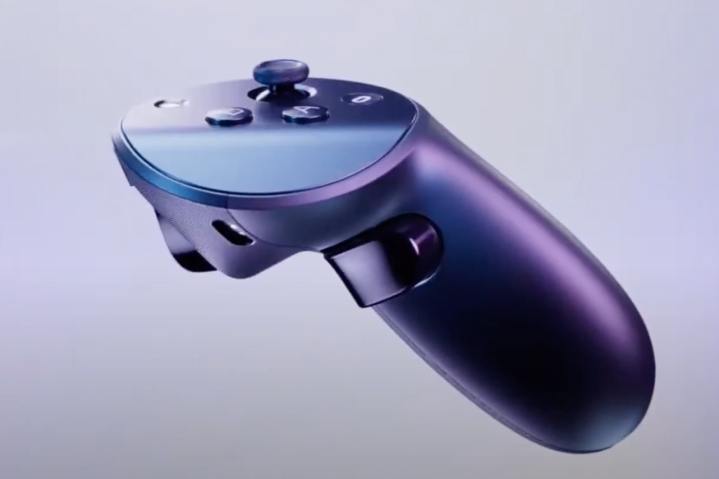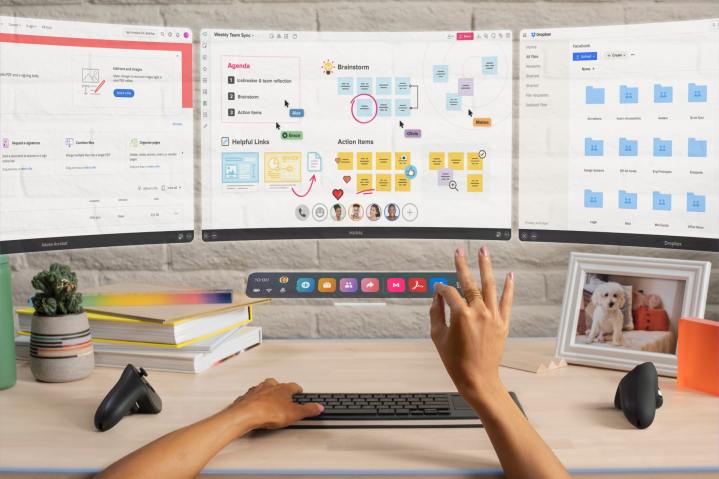Meta’s Quest Pro is now shipping and the first reviews have arrived, giving us some real-world insights into what to expect. Meta gave a surprisingly brief glimpse of the product in action during its Meta Connect event early this month but hands-on experiences are more revealing. Will the Quest Pro be worth the expense and is it really a productivity headset?
Brighter and clearer

Consumer VR headsets cost as much as $1,400 but the most popular of them all is the $400 Quest 2, so the Meta Quest Pro has to really shine to justify its $1,500 price. As a head-mounted display, the image quality is one of the most important features and most early reviewers were impressed.
CNET’s Scott Stein noted that there wasn’t a massive resolution increase compared to the Quest 2 but went on to share that “everything looks crisp and vivid. The display feels bright, and contrast and black levels are much better than on the Quest 2.”
T3’s Yasmine Crossland said, “the visual experience on the Meta Quest Pro is actually really impressive. Colours pop out at you and there’s lots of detail in the ‘world’ around you.”
Android Central’s Nicholas Sutrich expressed that “Working on the headset is surprisingly good, too. I had a lot of high hopes that this would finally be the virtual replacement for my giant 43-inch monitor/TV in my office when I’m not sitting there and, so far, it feels superb to work in this environment.”
Tech Advisor’s Lewis Painter notes, “Regardless of resolution specifics, there’s no noticeable screen door effect with the ability to clearly read text in VR without having to be right in front of it. That’s a boon not only for VR games, but working in virtual reality too.”
Premium VR comfort

Comfort is critical in a VR headset and the Quest Pro has several changes designed to improve how it feels. Most VR headsets press against your face but the Quest Pro has an all-new design that relies on a halo band. This is a very personal issue and reviews were mixed. It’s worth noting that reviewers have had limited time with the Quest Pro and it can take some time to adjust to any headset.
PCMag’s Will Greenwald said, “I found it largely comfortable and secure, and something I could physically wear for a long period of time. Physical comfort, however, doesn’t take into account the eye strain that any VR headset can cause, or the Quest Pro’s battery life.”
Android Central’s Nicholas Sutrich exclaimed, “In a nutshell, Meta took me from ‘there’s no way I’d wear a VR headset all day’ to ‘I can’t wait to wear this thing on a daily basis.’ It really is that comfortable.” Sutrich explained “this isn’t just any old halo strap. It’s actually a two-part strap that features rigid plastic around the outside and a flexible strap on the inside, helping to better hold it to your head in a soft way. That, combined with the reduced overall weight and the fact that the curved cell battery is in the back of the strap, makes it actually comfortable to wear for long periods of time.”
CNET’s Scott Stein expressed mixed feelings, with concerns about light bleeding in, stating, “I love that the Quest Pro fits over glasses easily because there are no sides to the headset. This has ups and downs, though. The Pro’s design keeps your peripheral vision mostly unblocked while in VR, which sometimes can help me know when things are nearby I should stay away from (or, keep an eye on my kids, sort of). Playing VR games like this, even in a well-lit room, isn’t as weirdly distracting as I thought it would be. But, this headset lacks good light blocking.”
Tech Advisor’s Lewis Painter also had some comfort issues, sharing that “the headset can still become uncomfortable over longer periods of use. I’ve noticed a build-up of pressure on the forehead on two of the longer VR sessions during my week and a bit with the headset that became so uncomfortable that I had to stop using the headset for a while. That can be alleviated by loosening the crank on the rear of the headset, but then the headset becomes loose and moves slightly during use.”
The new controller design

Meta introduced redesigned controllers for the Quest Pro and is selling them separately as a Quest 2 upgrade. Accounting for $300 of the Quest Pro’s price, the Quest Pro Touch Controllers provide another opportunity to impress reviewers.
Android Central’s Nicholas Sutrich explained, “the controllers are also millimeter accurate in their movements, and new pressure points on the controller allow for ‘precision pinch movement,’ as Meta calls it. In one demo, I was grabbing objects and squeezing them as I would expect to in real life.”
Sutrich went on to describe the Quest Pro Touch Controllers’ TruTouch Haptics, saying “Every UI element popped like never before, and grabbing objects felt more realistic because they could emit some sort of tactile response to virtual grabbing or touching.”
T3’s Yasmine Crossland exclaimed, “Everything about the Meta Quest Pro is easy to use, and that’s largely down to the controllers included in the box. They are undoubtedly the best VR headset controllers we’ve seen so far.”
CNET’s Scott Stein also liked the haptics but was concerned about the weight, stating, “Holding these controllers seems like it takes a bit more effort because they feel heavier, or I’m worried about dropping them. I make sure to wear the wrist loop.”
Tech Advisor’s Lewis Painter was impressed by the redesigned controllers, noting that they felt compact and light, going on to say, “The big change, as you might’ve noticed, is the removal of the tracking ring. This allows you to bring your hands closer together than ever before in VR (without hand tracking anyway!) without bumping the two large rings into one another. Paired with improved haptic feedback to better simulate the feel of whatever you’re holding or doing in VR, it’s a much more natural, immersive experience.”
Is Quest Pro worth the price?

Echoed throughout all reviews is the mention of the higher price of the Quest Pro. Every reviewer seems to agree that the design, construction, and implementation are representative of a high-end VR headset. The only real question is whether it’s worth the cost for you. As with any tech purchase, there’s much more to consider and a long-term review after a few weeks of use will uncover some benefits and concerns that would otherwise be missed.
The Quest Pro is definitely a VR headset that should be considered if you’re a VR enthusiast or work in that industry. Professionals that have a need to work in virtual reality might not consider the expense a problem, compared to the competing mixed-reality platforms like Microsoft’s HoloLens 2 or Magic Leap 2, which cost much more. Meta’s Quest Pro provides a high-end VR experience with a first step into the mixed reality that professionals want.


